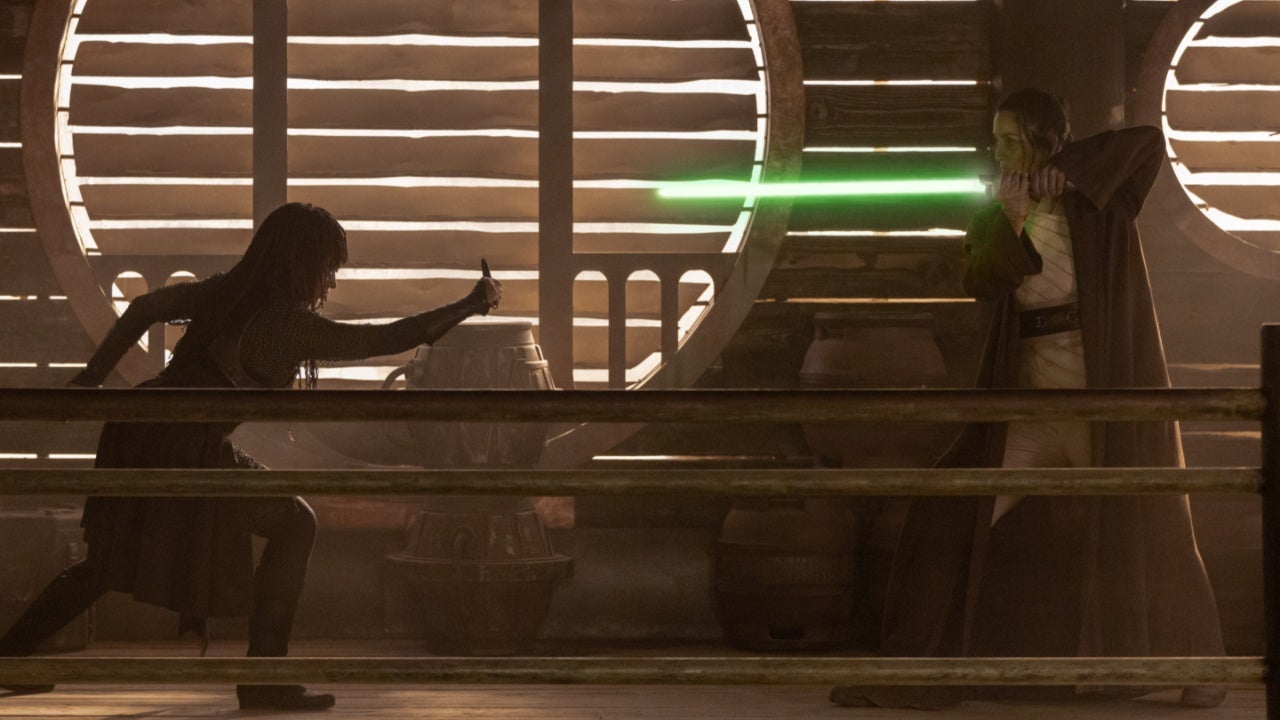Warning: This review contains full spoilers for Star Wars: The Acolyte Season 1, Episodes 1 and 2.
Watching the two-episode premiere of The Acolyte, it’s odd that this show was ever sold as one not about twins walking opposite paths of The Force. It’s not presented as a big reveal that Amandla Stenberg is playing two separate characters, given we simply meet sisters Mae and Osha in consecutive scenes of the series premiere and quickly get the basics on their long separation. But Stenberg does a good job of instantly differentiating the two through her physicality, with the warm and open Osha the polar opposite of the rigid and determined Mae.
Mae’s introduction, and her one-on-one fight with the Jedi Indara (Carrie-Anne Moss), is an exciting one. We’ve seen plenty of lightsaber duels in Star Wars, so having a Force wielder attack a Jedi armed only with throwing knives is a great way to mix things up. (It also shows that the Jedi are just as formidable without their trademark weapon.) Moss brings exactly the kind of attitude and physical prowess you’d expect after four Matrix movies, wonderfully conveying what little effort it takes for Indara to block and dodge Mae’s attacks. A similar fight scene between Sol (Lee Jung-jae) and Mae in the second episode is good too, but so far, this one is the highlight. And the way Mae triumphs – distracting Indara by throwing a knife at the bar owner, allowing her to strike a lethal blow with her second blade – feels darkly clever and believable.
So you’ve got cool action and a solid setup here with Mae targeting four specific Jedi for reasons yet to be revealed. But there’s a lot of The Acolyte that also feels clunky when it comes to the specifics of the storytelling. When Jeckie (Dafne Keen) suggests to Sol that Mae may be the killer, he is adamant that she is dead, only to instantaneously believe Osha when she tells him it was Mae. (Honestly, Jeckie would have been justified yelling out “Hello, I said the same thing and you blew me off!”) The Jedi Yord (Charlie Barnett) is shown to have a Padawan when we first meet him, but then when he’s recruited for Sol’s mission, she isn’t mentioned at all.
But beyond those weird hiccups, there’s the fact that the vibe isn’t quite right. I mentioned in my non-spoiler review of the first four episodes that The Acolyte often feels more like a Star Trek series – specifically from the Next Generation-era. There’s a big budget on display, but it looks visually inferior to a Star Wars movie – not the first time that’s been said about one of these Disney+ shows, but it’s more conspicuous here.
Also, a lot of the comedic banter intended to give these characters dimension falls flat. A quick rundown of eye-roll-inducing lines from the first two episodes: Osha joking how her buddy Fillik is disposable but she’s not, the double “ugh” we get from two Neimoidians, and Osha actually doing a “can you give me a hand?” pun when asking for the detached droid limb that could free her from the cell of a prisoner transport ship. That prison ship sequence is another that oddly undercuts itself. A tense, quintessentially Star Wars “How will she get out of this one?” situation with Osha stuck on a crashing ship, with no escape pods left, only for her to… survive the crash just fine? All she had to do was strap into one of those seats and all was well? Huh.
The Acolyte is better when it comes to its worldbuilding. On a production design level, there’s some fun to be had with the fact that story is taken place a century before the Skywalker Saga – and yes, they do still have hyperspeed and holograms and most of the familiar trappings we know, but the actual devices and consoles look larger and more unwieldy. There are some great details, like the lighting on the side of the pilot droids’ faces looking like something right out of a 1970s sci-fi movie. No, not Star Wars itself, but the other sci-fi movies from that era, which had a less distinctive aesthetic.
The Jedi forbidding “attachment” has always felt like a topic worth examining. If Anakin hadn’t felt he had to keep his marriage with Padme a secret, would things have turned out better? Or should he have simply never gotten romantically involved with her at all, more strictly following the Jedi way? Jecki worrying that Sol keeping holos of his old Padawan “encourages sentimentality and nostalgia” and insinuating this should be avoided at all costs opens the door to this show further exploring just what it means to be a Jedi – and if their approach is the right one.
And while we don’t know the full extent of these characters’ shared history, Episode 2 may provide some clues. The fact that the Jedi Torbin (Dean-Charles Chapman) apologizes to Mae and tells her “We thought we were doing the right thing” – right before willingly drinking the poison she brought him – feels notable for how it’s presenting the Jedi. George Lucas has noted the Order set itself up for its fall via a lot of self-inflicted flaws. At one point, Mae’s ally Qimir (Manny Jacinto) says “The Jedi justify their galactic dominance in the name of peace and peace is a lie,” expressing a disdain for the Jedi that we can assume others share. It’s the kind of idea that Palpatine would eventually be able to take advantage of when crafting his plan to take down the Order.
Some other thoughts:
-Stenberg is doing strong work in her dual role, but Lee Jung-jae gives the best performance in these two episodes. He conveys so much with his eyes as Sol, who says things like “I’ve made peace with what happened on Brendok” in a way that suggests he most certainly has not.
-It’s cool to see Yord use a yellow lightsaber. Some may think of Rey’s lightsaber at the very end of The Rise of Skywalker, but they were already established as canon via Star Wars: The Clone Wars, where yellow was the color of the blades used by the Jedi Temple Guards. And of course, that color will always make for an amusing callback to the miscolored blade the original Luke Skywalker Kenner action figure had back in the 1970s.
-Though set long before the prequels, The Acolyte feels much more in line with their world than the one of the original trilogy. The appearance by the Trade Federation and the Neimoidians here – who, thankfully, sound a lot less like racist caricatures than those in The Phantom Menace – feels like a purposeful nod to that connection.
-Having the innately likable Manny Jacinto as Qimir is clever and subversive casting. He’s playing a variation on a familiar Star Wars character type – the lovable scoundrel/rogue – except he’s actively rooting for and aiding the Jedi’s demise.
-The “local Jedi temple” on the planet Olega is a nice touch, showing how the Jedi might have these different outposts across the galaxy for those spending a long time away from Coruscant and the main temple we’re familiar with. However, it makes little sense that Mae goes through all that trouble to sneak into the temple using that little girl, then hides from the first two Jedi she sees, only to just walk right by another person inside, who doesn’t seem to care if this stranger is in there at all.
-What a weird final note to end the second episode on. Seeing a Jedi Wookiee, Kelnacca (Joonas Suotamo, who’s played Chewbacca in all his recent appearances), in action using the Force is great. But then we cut to credits on him just sort of walking up and opening a door. It’s reminiscent of how the early episodes of Andor concluded on odd, non-ending moments. Hey, that show turned out amazing, so fingers crossed history can repeat itself.
-That guy with the alien parasite over his mouth totally looked like Glenn Howerton when you could only see the top of his face, and it was a little disappointing when it ultimately turned out not to be Glenn Howerton.









